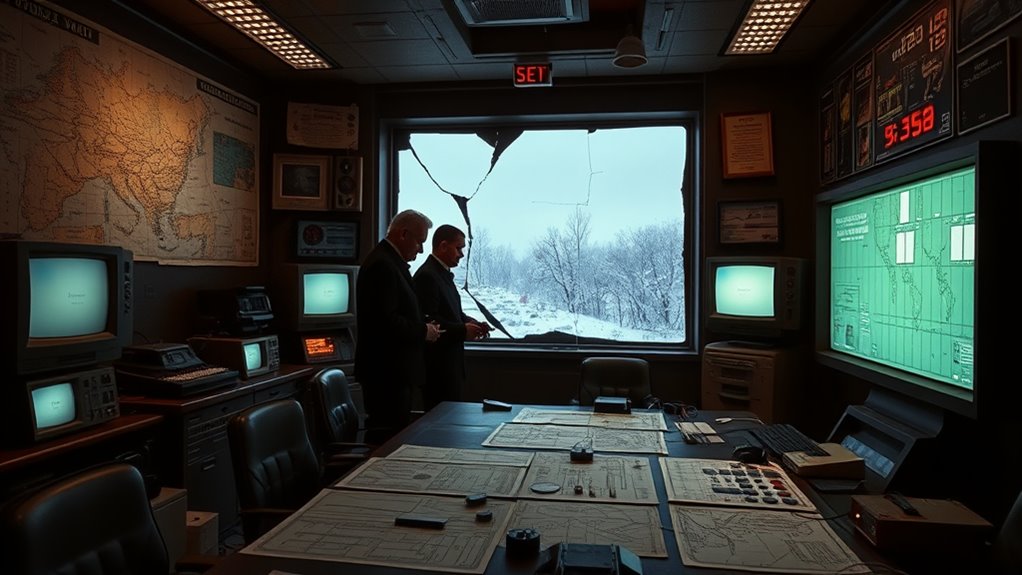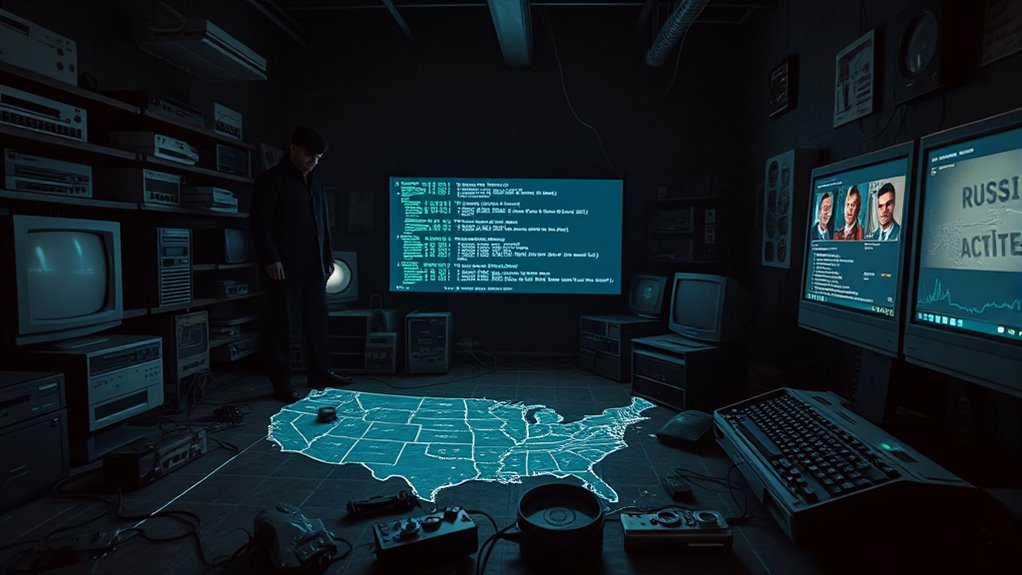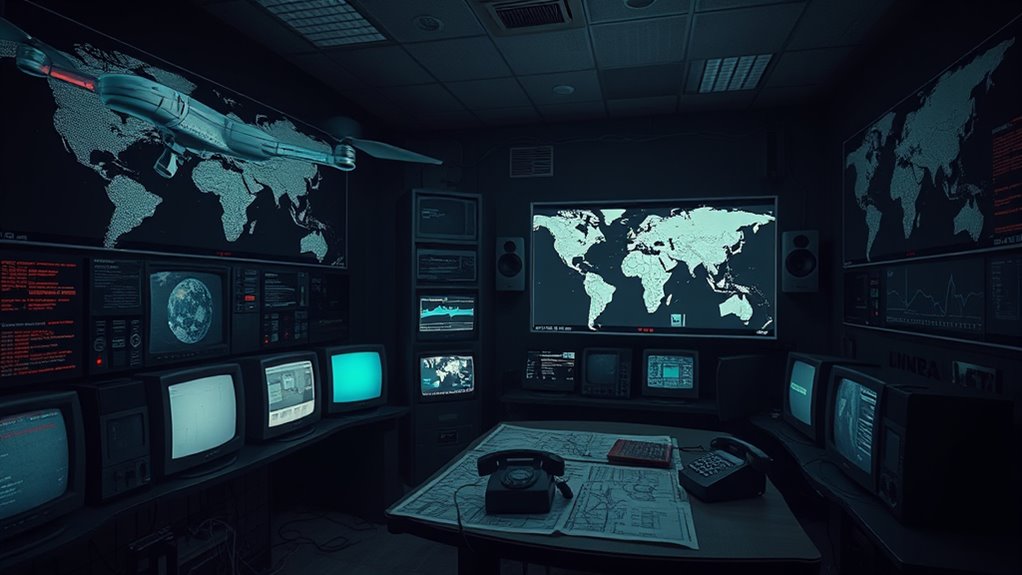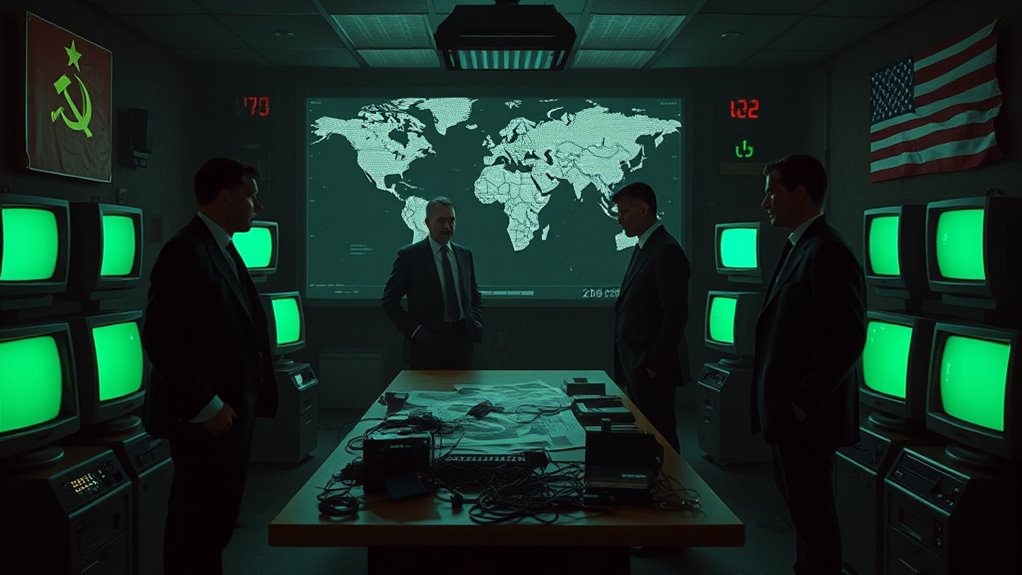The Cold War's espionage tactics, particularly from the U.S. and Russia, laid the groundwork for today's AI-driven intelligence operations. Innovations in surveillance technology, like coded communications and microdot cameras, evolved into digital methods that revolutionized data collection. Major spy rings demonstrated the importance of human intelligence and disinformation, which continues to shape modern strategies. As AI emerges, it transforms how nations analyze information, driving new intelligence capabilities. There's much more to discover about this enduring impact.
Key Takeaways
- Cold War espionage laid the groundwork for modern intelligence methods, emphasizing human infiltration and intelligence gathering techniques that adapt to technological advancements.
- The development of digital surveillance technologies during the Cold War led to the evolution of cyber capabilities in intelligence operations.
- Disinformation tactics used in the Cold War have been adapted to modern contexts, influencing contemporary AI-driven propaganda strategies.
- AI enhances intelligence operations by processing vast data, reflecting the Cold War's emphasis on predictive analytics and threat anticipation.
- Cold War practices continue to shape current espionage, with agencies leveraging historical strategies to inform AI-driven approaches in cyber operations.
The Roots of Cold War Espionage

Although the Cold War is often remembered for its political and military standoffs, its roots in espionage run deep, tracing back to World War II. During this time, Soviet intelligence began to establish an extensive espionage network in the U.S., primarily focused on nuclear secrets.
Key spy rings like the Cambridge Five and the Portland Spy Ring played significant roles, gathering intelligence from influential individuals. As tensions between the superpowers escalated, the Cold War intensified these efforts.
The Venona program, initiated in 1946, decrypted Soviet intelligence messages, exposing many spies involved in the Manhattan Project. This reliance on human intelligence underscored the importance of infiltration and recruitment, setting a foundation for modern espionage practices still relevant today.
Innovations in Surveillance Technology

As the Cold War unfolded, intelligence agencies raced to develop innovative surveillance technologies that would give them an edge in the ongoing struggle for dominance.
Here are some key advancements that shaped espionage during this era:
- F21 Ammer Spy Camera – A discreet tool for capturing images without detection.
- Microdot Cameras – Enabled operatives to gather and transmit intelligence in minuscule formats.
- Coded Communications – Encryption techniques guaranteed secure transmission of sensitive information.
- Hidden Microphones and Tracking Devices – Facilitated constant monitoring of adversaries and intelligence gathering.
These innovations in surveillance technology not only revolutionized espionage tactics but also laid the groundwork for future advancements in intelligence gathering, greatly impacting how nations approached security during and after the Cold War.
Major Spy Rings and Their Impact

When you think about the Cold War, the impact of major spy rings like the Cambridge Five and the Atomic Spies can't be overlooked.
Their actions not only provided essential intelligence to the Soviets but also reshaped U.S. intelligence strategies.
Understanding their influence helps you appreciate the complex landscape of espionage that emerged during this tense period.
Cambridge Five's Influence
The Cambridge Five, a notorious spy ring, profoundly shaped the landscape of espionage during the Cold War. Their actions exposed significant vulnerabilities in British intelligence, leading to lasting consequences.
Here are four key impacts of their infiltration:
- Undermined Trust: Their betrayal created deep distrust within British intelligence circles.
- Strategic Intel Leaked: They relayed vital wartime strategies and nuclear capabilities to the Soviet Union.
- Counterintelligence Reforms: Their success prompted major reforms aimed at enhancing counterintelligence measures.
- Legacy of Recruitment: The Cambridge Five's methods illustrated the effectiveness of personal relationships and ideological alignment in espionage operations.
Ultimately, their legacy continues to influence how intelligence agencies operate and recruit agents today. Additionally, their infiltration exemplified the dangers of emotional manipulation in the realm of espionage, highlighting how personal connections can be exploited for strategic gains.
Atomic Spies' Significance
Espionage didn't stop with the Cambridge Five; it evolved and escalated through various spy rings, particularly the Atomic Spies. Key figures like Klaus Fuchs and the Rosenbergs greatly impacted Soviet nuclear capabilities. Fuchs' leaks from the Manhattan Project fast-tracked the USSR's atomic bomb development, culminating in their successful test in 1949. The execution of Julius and Ethel Rosenberg in 1953 underscored the fear of Soviet infiltration in the U.S. government. The Venona project later revealed the extensive reach of Soviet espionage, confirming multiple American spies' involvement. These events not only heightened Cold War tensions but also reshaped U.S. national security policies, leading to stronger counterintelligence measures.
| Spy Ring | Notable Figures | Impact |
|---|---|---|
| Atomic Spies | Klaus Fuchs, Rosenbergs | Advanced Soviet nuclear program |
| Cambridge Five | Philby, Burgess | Influenced intelligence trust |
| Red Orchestra | Richard Sorge | Provided essential intel |
The Role of Disinformation Tactics

In today's world, disinformation tactics play a vital role in manipulating public perception, especially through cyber propaganda strategies.
You'll see how Russian intelligence operations exploit social media to spread false narratives that create confusion and distrust.
This modern approach marks a significant shift from the covert methods used during the Cold War.
Manipulating Public Perception
Here's how manipulating public perception unfolds through disinformation campaigns:
- Targeting Social Divisions: Russian spies exploit societal rifts in countries like Mexico to weaken support for Ukraine.
- False Narratives: Claims of U.S. alliances with Mexican drug cartels create confusion and distrust among citizens.
- Social Media Bots: Intelligence agencies utilize automated accounts to spread misinformation and foster anti-U.S. sentiment.
- Ongoing Monitoring: U.S. and European officials are increasingly vigilant, developing strategies to counteract these propaganda efforts.
As the digital age evolves, these tactics reveal striking parallels to Cold War espionage methods, emphasizing the ongoing relevance of disinformation in global politics. Additionally, the rise of social justice movements has shown how quickly misinformation can mobilize public opinion and incite unrest.
Cyber Propaganda Strategies
Disinformation tactics have evolved considerably, blending traditional espionage with modern technology to create powerful cyber propaganda strategies.
Russian intelligence now leverages social media bots and targeted misinformation campaigns to manipulate the information landscape, particularly in regions like Latin America. By promoting false narratives, such as the fabricated report on U.S. recruitment of Mexican drug cartels for Ukraine, they aim to distort perceptions of U.S. foreign policy and sow discord.
This aggressive posture reflects a sophisticated hybrid operation that seeks to exploit social divisions, undermining international support for Ukraine and disrupting U.S. alliances.
As you navigate this complex landscape, it's essential to recognize how these disinformation tactics not only influence local opinions but also reshape global political dynamics.
Transitioning to Digital Espionage

As the Cold War drew to a close, intelligence agencies began embracing technology to adapt their espionage tactics.
The shift to digital espionage marked a significant evolution in intelligence gathering, driven by advancements in computer technology.
Here's how this change unfolded:
- Internet Development: The rise of the internet opened new avenues for data collection.
- Cyber Capabilities: Agencies enhanced their surveillance and hacking skills, moving away from traditional methods.
- Malware Utilization: Espionage tactics evolved to include malware for information theft.
- Russian Strategies: Russian intelligence increasingly turned to cyber warfare, focusing on disinformation and manipulation.
This change reflects a fundamental change in how nations conduct espionage, highlighting the importance of adapting to an increasingly digital world.
The Emergence of AI in Intelligence Operations

With advancements in artificial intelligence (AI), intelligence operations have undergone a dramatic transformation that enhances both effectiveness and efficiency.
Intelligence services now leverage AI technologies to process vast amounts of data, far exceeding human capabilities. As an intelligence officer, you benefit from AI's ability to identify patterns and anomalies in surveillance data, improving espionage and counterintelligence efforts.
Intelligence services harness AI to analyze extensive data, enhancing pattern recognition and bolstering espionage and counterintelligence operations.
Machine learning algorithms support predictive analytics, helping you anticipate potential threats and streamline decision-making processes. Additionally, the rise of AI-driven cyber warfare capabilities means automated attacks and defenses are reshaping modern covert operations.
This evolution marks a significant shift from traditional methods, reflecting how Cold War tactics have adapted to sophisticated technological approaches in intelligence gathering and operations.
Contemporary Implications of Cold War Practices

Although you may not realize it, the espionage tactics developed during the Cold War still shape modern intelligence operations. Here are some contemporary implications:
- Cyber Capabilities: Nations now utilize cyber tools for surveillance, mimicking KGB and CIA methods.
- Geographic Strategy: Russia's operations in Mexico reflect Cold War practices of leveraging proximity to the U.S. for intelligence gathering.
- Disinformation Campaigns: Modern disinformation efforts, particularly by Russia, echo tactics used during the Cold War to manipulate public perception.
- Legacy of Spy Networks: Historical networks, like the Cambridge Five, continue to influence how contemporary intelligence agencies operate.
These elements illustrate how the past informs current strategies, proving that Cold War espionage remains relevant in today's digital landscape.
Frequently Asked Questions
Did the US Have Spies in Russia During the Cold War?
Yes, the U.S. had spies in Russia during the Cold War. They used various methods to gather intelligence, including undercover agents and surveillance techniques.
Notable figures, like Oleg Penkovsky, provided essential information about Soviet military capabilities. The U.S. also decrypted Soviet communications through the Venona project, revealing the extent of espionage on both sides.
These operations greatly shaped U.S. strategies and responses in the ongoing conflict with the Soviet Union.
How Did the Cold War Affect US Intelligence?
The Cold War shaped U.S. intelligence in critical ways: it heightened efforts to gather information, it fostered the creation of agencies like the CIA, and it intensified the focus on countering adversaries.
You'll notice that espionage incidents raised public awareness and created distrust, while the need for Russian-speaking agents pushed the intelligence community to adapt.
Ultimately, these developments influenced national security policies and continue to affect intelligence practices today.
How Did Spies Play a Role in the Cold War?
Spies played an essential role in the Cold War by gathering critical information and influencing strategies.
You'll find that espionage efforts, like the Cambridge Five, infiltrated key intelligence agencies, while programs like Venona decrypted enemy communications.
These activities revealed secrets about nuclear capabilities and intentions, shifting the balance of power.
You can see how spies not only gathered intelligence but also instilled fear and uncertainty, shaping the geopolitical landscape during this tense era.
What Was the Russian Spy Agency During the Cold War?
The primary Russian spy agency during the Cold War was the KGB, or Committee for State Security. Established in 1954, you'd find it notorious for its covert operations and espionage activities.
The KGB used various tactics, including deploying "illegals"—spies with false identities—to infiltrate foreign governments. It played a vital role in gathering intelligence on Western nations, particularly concerning nuclear capabilities and military strategies, greatly impacting the global power dynamics of the era.
Conclusion
In the shadow of the Cold War, the seeds of modern espionage were sown, growing into a tangled web of digital intrigue. As Russia and the U.S. embraced technology, they transformed intelligence operations into a high-stakes game of cat and mouse. Today, as AI takes center stage, the echoes of those early spy games remind us that the past isn't just history; it's a blueprint shaping our future. The dance of deception continues, with new partners and ever-evolving steps.








